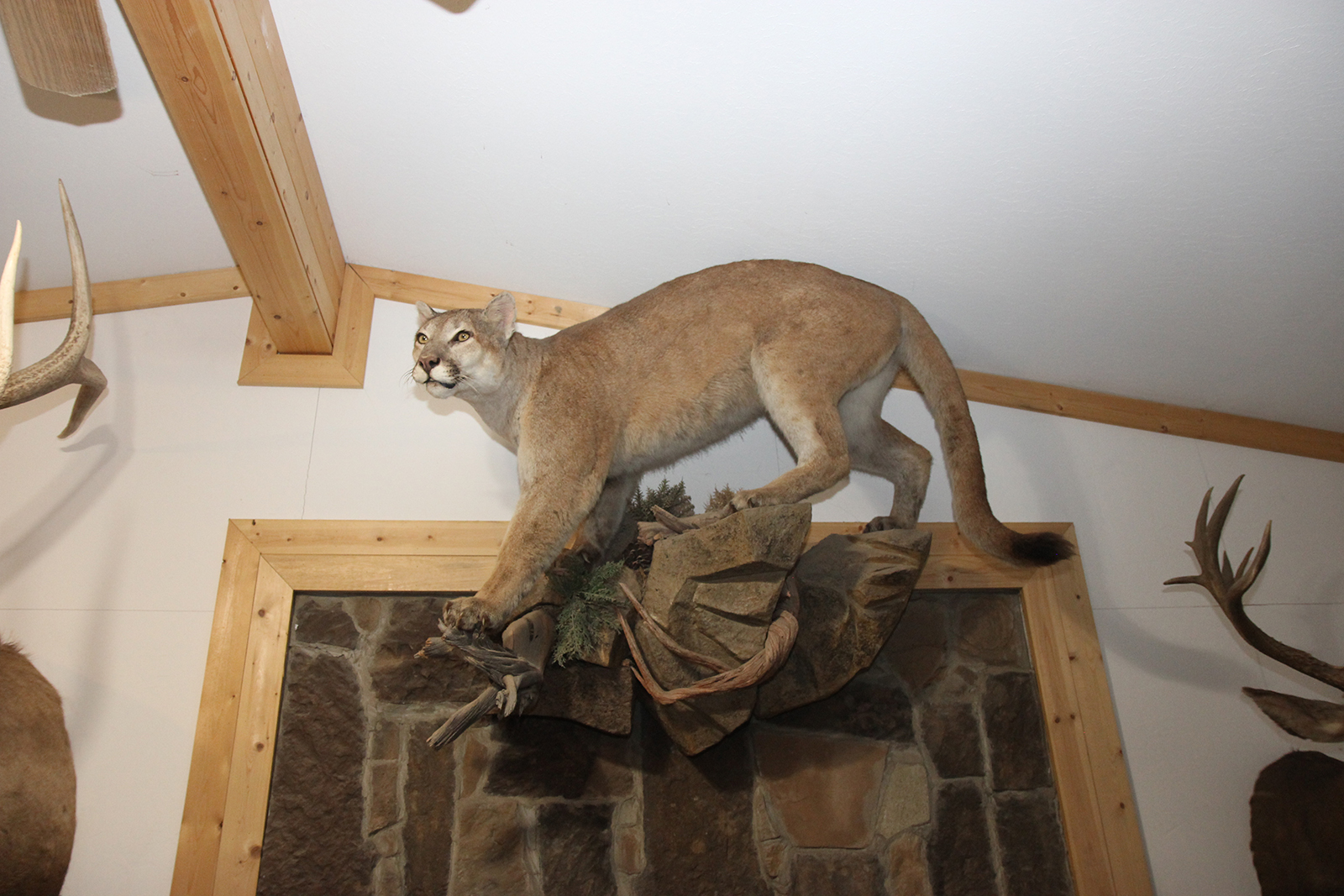
In-Depth
Hyper-visitation, the Fate of the National Parks, and Tourism Toxification in a Small Town
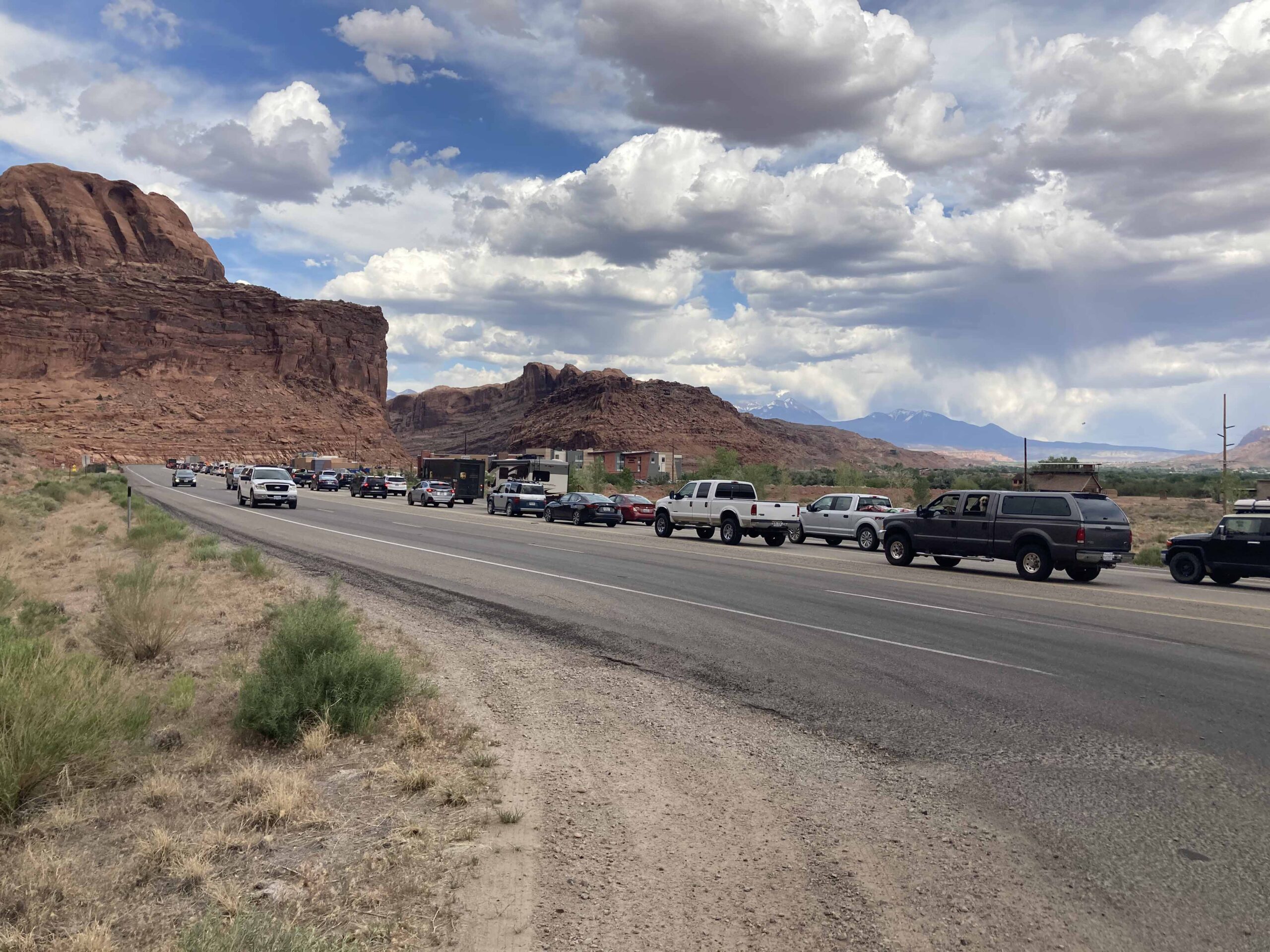

by Christopher Ketcham – 04.12.2023 – 25 min. read
The trouble at Arches National Park starts at the entrance during the spring and summer, when visitation is at its highest. First, there’s a 40-minute queue of idling traffic to reach the fee booth, which is a quarter-mile off busy U.S. Route 191. When I visited in May 2021, I asked the boothkeeper, a middle-aged woman in Park Service green and flat hat, how she felt about the crowds.
“Oh, god,” she said. “I don’t want to talk about it. Let’s just say I’m very tired.”
Onward into the park: more traffic, under a pounding desert sun. Moms screamed at each other over parking spots. After cramming my rental car into one of the coveted spaces, I fled the lot for the trails, where I found more people, noise, and a shocking amount of garbage. The interpretive rangers, those who muck it out in the crowds to avoid the torture of the fee booths, wore anxious faces and plastic smiles, scurrying to deal with the excess of humanity. In 1996, about 856,000 people visited Arches, and even then managers reported that the visiting public believed that the crowding was too much. Between 2006 and 2019, the number more than doubled, to 1.8 million. At current growth rates, visitation will double yet again by the early 2030s. Not one of the rank-and-file employees I spoke to at Arches thinks these are statistics to be glad about. They are understaffed and overworked, but their most salient concern is that they are demoralized. They do not comprehend why their leadership has failed to take an effective stand on the growth of visitation.
On another visit that May, by 8:30 in the morning, I found Arches “a madhouse,” as one ranger described the situation to me. Every parking lot at every turnout, viewpoint, and trailhead along the paved, 18-mile, two-lane access road was full. At various choke points, the traffic had come to a standstill, and at the park entrance, the cars were backed up to 191. By 8:45, the superintendent closed the park to all but those on foot. Two miles away, in the town of Moab, the gateway community to Arches, the news circulated on social media. The people needed somewhere to go. Seeking satisfaction, unhappy motorists turned north with locust-like determination, aiming their engines at Island in the Sky, a dramatic mesa in nearby Canyonlands National Park, 30 miles by paved road from Arches. By 10:30, the rangers on patrol in I-Sky, as the area is known, reported to their superiors with a kind of despairing hilarity that parking had reached 100 percent capacity at every lot there too. There were jokes about sending tourists off cliffs to find parking. The toilets were “trashed,” according to the rangers, and the garbage bins were a “godd— mess.”
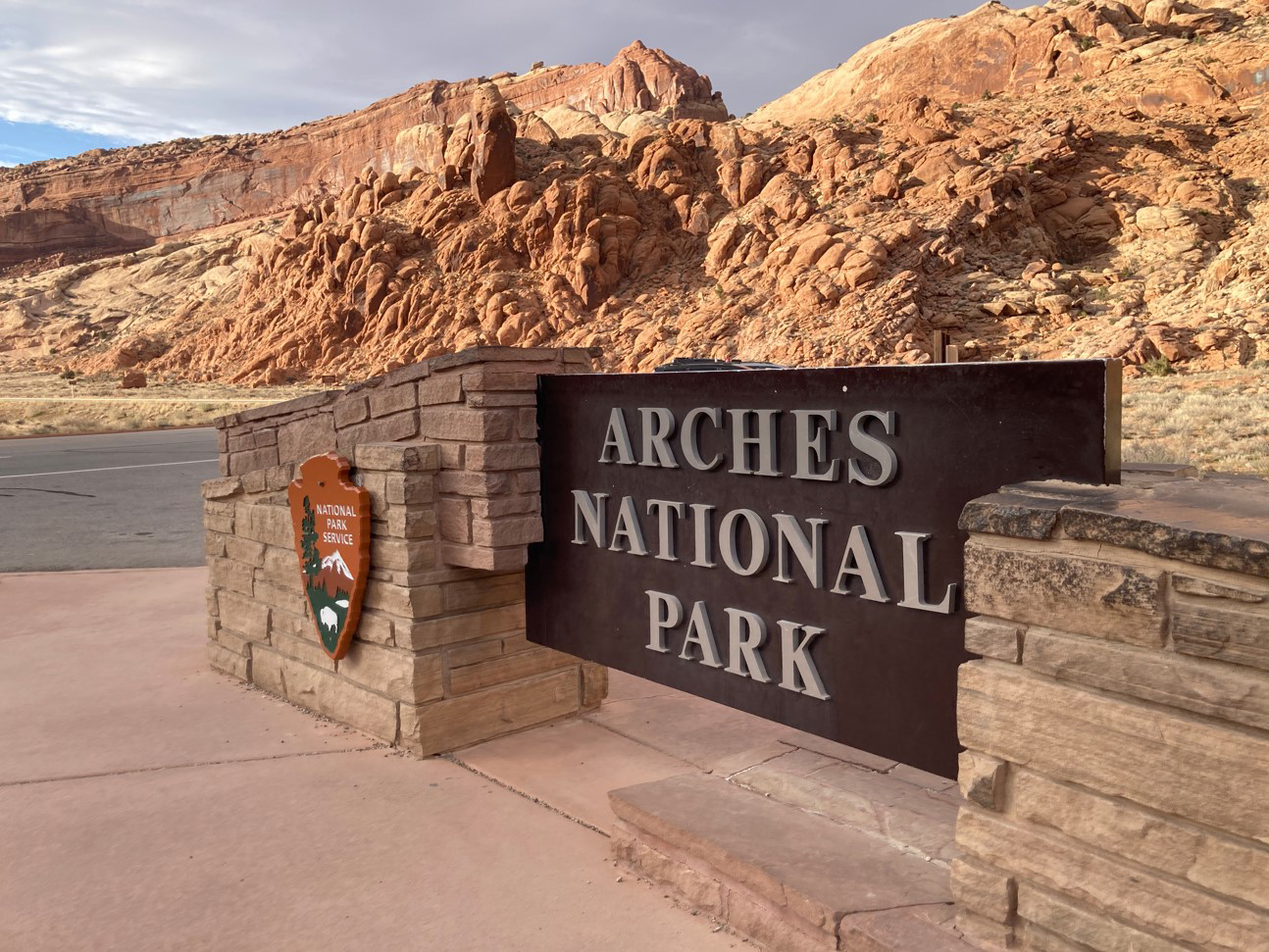
I joined one of Canyonlands’ seasonal interpretive rangers—the Park Service employees you see on the trails guiding visitors, explaining the geology and flora—to take a walk along the soaring rim of the I-Sky mesa. The view below, of the Colorado and Green Rivers meeting in a maze of red rock sandstone, was lovely in its immensity. But it was little consolation. The ranger felt awful about her job. I asked her to go on the record, but she was scared about criticizing “the holy grail of more visitation,” and expected that if she did so that she could be fired.
This was not long after the lifting of the lockdowns post-COVID. There was an ugly distinctiveness in the type of visitor now in southern Utah, an ugliness that made her depressed and anxious. Visitors drove vehicles off road, shouted obscenities, littered, and defecated literally “all over the place.” “It’s a new kind of lack of respect,” she told me. “Lots of vandalism. Selfishness run amok. A gross ego-driven extreme sports thing. People are thinking more than ever about recreational pursuit, not about the land. I mean, this isn’t new. It’s just worse now.”
“Hyper-visitation” in the crown jewels of public lands is a national issue, as parks everywhere take a beating from crowds. In 2016, the parks system marked a milestone, welcoming the most visitors ever in its history, some 331 million people, a thousand times the number of visitors exactly a century earlier, in the year of the system’s founding, when a mere 326,000 passed through park gates. Though the aggregate volume dropped by a hundred million people post-pandemic, many parks, like Arches, are still overwhelmed.
Crowding, however, does not necessarily contradict the aims of the law that established the National Park Service. The Organic Act of 1916 mandated that the agency “provide” the public the means of “enjoyment” of “scenery and the natural and historic objects and the wildlife therein”—a directive that, when facilitating enjoyment for as many people as possible on pleasure-seeking tours, appears easy to satisfy. At the same time, the legislation mandated that park managers “conserve” that same scenery and wildlife “by such means as will leave them unimpaired for the enjoyment of future generations.” When a mere several hundred thousand a year visited parks, these two goals were not visibly at odds; pleasure-seeking in the present was not yet an environmental force that threatened to impinge on future enjoyment. Today, however, the parks struggle under an intractable tension. The number of visitors at once exceeds what the landscape can withstand and compromises the enjoyment of the visitors themselves.
The people who work in parks are the first to say that the management model has veered into toxic dysfunction. From the perspective of the ranger I interviewed in I-Sky, the matter was simple: The Park Service needed to set limits to the growth of visitation. But administrators weren’t interested in limits. There was talk of building bigger parking lots to accommodate still more people in both Arches and Canyonlands. “If they do that, f— the National Park Service,” the ranger told me. “I quit.”

The Parks’ current troubles can be directly traced to the prevailing values of the era in which they were created. The spirit of Henry Ford presided over the birth of the Park Service. Auto-tourism was all the rage, and in the 1920s, the Service was quick to embrace the paradigm that more cars would mean more visitors, more visitors would mean more public support for parks, more public support would mean more influence in Congress for bigger budgets. Obviously more roads needed to be built, along with more infrastructure to support the larger crowds in their fast-paced autos: bigger visitor centers, more and bigger lodges, more viewpoint pull-offs on the ever-expanding roads, and more walking trails.
After World War II, visitation reached levels that Park Service officials a few decades earlier could hardly have believed possible. By the 1960s, NPS administrators worried that the public’s experience of parks was suffering, and by the 1970s, lawmakers took notice. Congress began crafting legislation to limit visitors to national parks and spare people the immiseration that comes with overcrowding. The 1978 National Parks and Recreation Act required the Park Service to institute social and ecological carrying capacities in order to address the problem of hyper-visitation. The NPS didn’t exactly rush to fulfill the congressional mandate. It took more than a decade for it to outline, agree on, and finally release from the slow-moving bowels of bureaucracy the Visitor Experience and Resource Protection program, or VERP.
VERP was radical. For the first time in the history of the Park Service, the agency was to establish social and ecological carrying capacities—the number of visitors the park could reasonably support without harming either their experience or the survival of plants and wildlife—and a ceiling on visitation. Arches, importantly, was the pilot site for VERP, the place where the program would be tested for use in parks nationwide.
Congress was clear that the responsibility to determine carrying capacity for the parks would rest with individual park superintendents, who would have to champion the effort using “the best available natural and social science” to produce “desired resource conditions and visitor experiences for the area.” At Arches, that superintendent was Noel Poe, a veteran NPS staffer who headed up the park from 1990 to 1995. Poe announced that under his watch, VERP planning, which began in 1991, would serve as the model for all other parks to deal with a problem that was appearing to veer particularly out of control at Arches. Visitation had gone from 150,000 in 1965 to 700,000 in 1991, and internal documents from the 1990s revealed the profound concern of Poe and his administrative team. “Doubling time went from 20 years to 6 years,” explained a 1993 planning memo. “It took this park from its establishment in 1920 until the 1980s to serve one million visitors; in the near future, this is the expected yearly visitation.” “It was alarming,” said a manager who worked alongside Poe.
VERP’s initial phase, which lasted several years, consisted of interviews with thousands of visitors to discuss their experience. The most important insight gleaned from this public counsel phase of the program was that people polled in Arches wanted fewer of themselves – not more visitation, but less. In the language of visitation planning, they were “crowding-intolerant.” Accordingly, administrators proposed limits to parking spaces and the number of visitors at each turnout and scenic trail. “I do not believe that national parks should always build more and more facilities in order to meet ever-increasing visitation,” Poe stated in a 1993 VERP planning document—though this was exactly what the park service had been doing for decades.
In a 1994 statement of “proposed management actions to address increasing visitor use,” Poe asserted that “the first action that should be taken to return use levels to acceptable conditions is reduce the areas available for parking.” Again, he was contradicting decades of park service orthodoxy, which maintained that parking areas should be constantly expanded. Officials floated numerous other ideas for regulating visitation, and premier among them was the establishment of a reservation system. Forcing the public to make reservations for a visit wouldn’t necessarily deal with overall numbers of people, of course. It would merely spread the people out, without imposing a cap on the total visits per day. The park would still be crowded, but visitors would be dispersed in what the Park Service believed would be manageable intervals.
Faced with the prospect of limiting visitors, businessowners in Moab, who were increasingly dependent on revenue from visitation at Arches, descended into hysterics. “There were folks, including the mayor, who thought this huge axe would come down,” VERP planner Karen McKinlay-Jones, an administrative ranger who worked for 20 years at Arches, told me. “That was the doomsday theory of how we were going to implement VERP.” The proposal for a reservation system was a nonstarter, so hostile were tourism interests in Moab. “By god, don’t use the ‘R’ word,” said McKinlay-Jones, who worked closely with Noel Poe on VERP. The idea of being forced to make a reservation at the park, she told me, not only threatened profits, it “went against the American ethos of ‘I wanna do what I want, when I want, and screw you people.’”
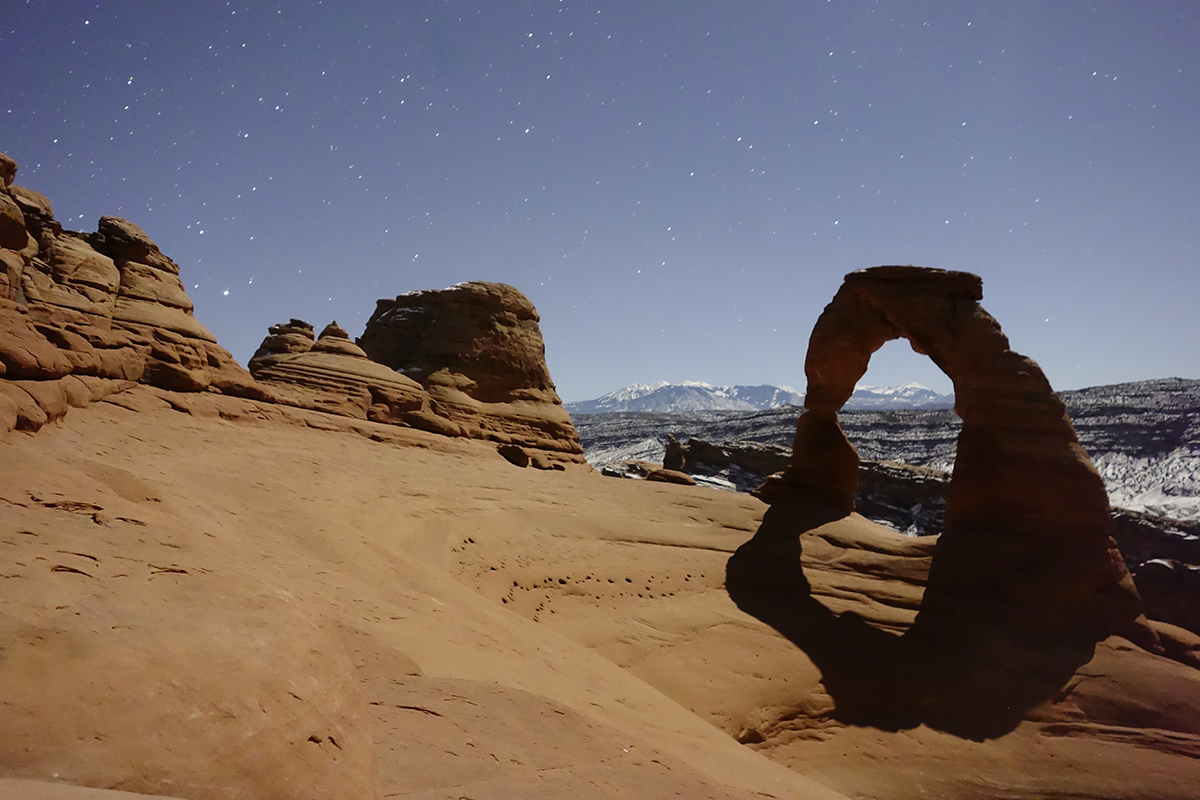
In 1995, when Poe attempted to limit the number of parking spots at the trailhead to the most iconic geological form in the park, Delicate Arch, hotel operators in Moab circumvented his efforts. According to Poe, hotels hired van services to haul in dozens of people at a time, dropping them off in droves, hour after hour, while not taking up a single parking spot. With this organized sabotage by businessowners, crowding became worse than ever at Delicate Arch. “As superintendent, I should have foreseen this happening,” Poe told me. “Instead, it hit us like a slap across the face.”
By the late nineties, Poe was gone from Arches, having taken a superintendency in Theodore Roosevelt National Park. McKinlay-Jones had departed for a chief ranger position at Death Valley National Park. “I couldn’t take it anymore,” she told me. “I was getting paid way too much to be a parking-lot attendant.” Poe and McKinlay-Jones had been VERP’s major champions, but their successors had little enthusiasm for the program. By 2000, the program seemed to be headed for the bureaucratic dustbin, and none of its proposals were implemented.
VERP was piloted and later abandoned in six other parks. In her 2012 book The Soul of Yosemite, Barbara Moritsch, a ranger in Yosemite National Park, recounted the failure of upper management to take VERP seriously at Yosemite during the 2000-2005 period when the program was supposed to have been implemented. It was incredibly difficult, Moritsch reflected, to determine social and ecological carrying capacity. Should they measure the impacts of visitation on the number of aquatic insects, deer, black bear? Should they measure the purity of the air, the darkness of the night skies, the number of clean restrooms, visitor testaments of plentiful solitude and quiet or the lack thereof? She and her colleagues wondered how many people might picnic on a riverbank before it’s damaged. What constituted damage? How many people could picnic on a riverbank at one time and still allow everyone present to have a “high-quality experience”? What constituted a high-quality experience?
As at Arches, there was little follow-through from upper management. “The park’s level of commitment was made painfully clear,” Moritsch wrote. By 2005, it was clear that “no money would be forthcoming to implement Yosemite’s VERP program.” Starved for funding, the program was “whittled down until it became almost meaningless, grossly inadequate for understanding, measuring, or limiting impacts on resources or the quality of the visitor experience.”
When I spoke with Moritsch recently, she reiterated that VERP “could have provided a clear direction for the NPS to meet both of its key mandates in Yosemite—to preserve resources and allow for their enjoyment—and could have provided an invaluable model for other NPS units to follow. Because it was never developed, crowding and resource damage continue to worsen every year.”
During the 2000s, at not one of the six VERP parks was there any effort to hold visitation to levels that the Park Service had determined were socially acceptable. This systemic failure at national and regional levels suggests that Park Service leadership decided it would let VERP die quietly while allowing exponential rises in visitation to continue. The program may have been too radical for the service’s starched-shirt bureaucracy. Its advice, after all, flew against the imperative of endless growth in a capitalist society.
At Arches, the new superintendent, Kate Cannon, who served from 2006 to 2019, acted in direct contradiction of Noel Poe’s counsel while holding true to the growthist bent that had characterized the National Park Service from its inception: She oversaw the construction of new and larger parking lots at all the major attractions, and new and wider roadways everywhere in the park. Today, the goal posts of acceptable levels of use have shifted, and management strategies once considered environmentally heinous at Arches are now thought to be sustainable. Consider the “air tour management plan” the Park Service adopted with celebratory fanfare in 2022 for Arches and Canyonlands national parks and Natural Bridges National Monument. In the 1990s, southern Utah parks managers expressed profound concern about noise pollution from low-flying aircraft. Noise levels were monitored to establish a baseline of data for use in confronting the air tour industry. But by the early 2000s, those initiatives fell by the wayside. The 2022 air-tour management plan permits levels of noise pollution from overflights that park staff in 1995 would likely have found to be abominable.
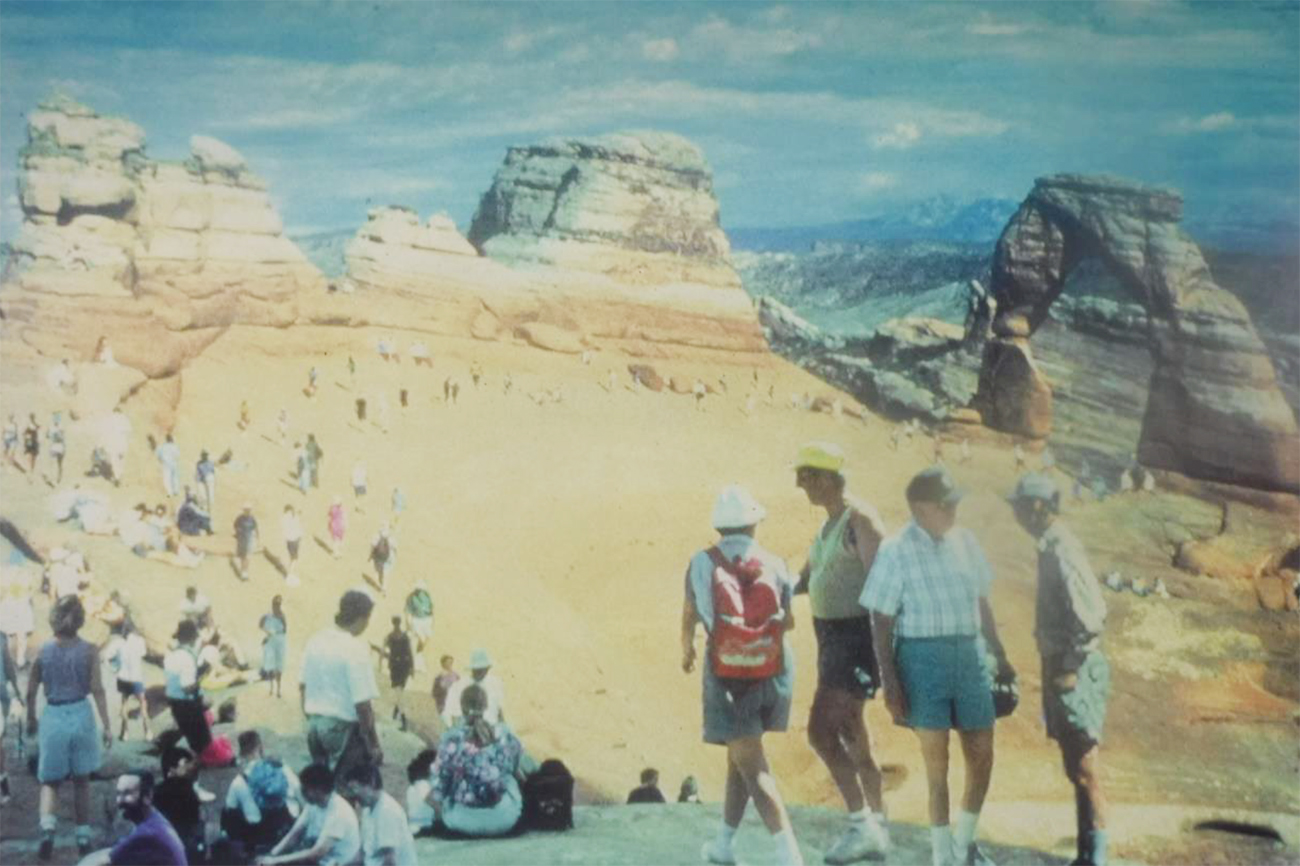
The benefits of reduced visitation are not merely theoretical. Recent experience demonstrates how the parks might improve with fewer visitors. During the COVID lockdown in the spring of 2020, Utah’s Grand County, which encompasses Arches, issued an unprecedented ordinance prohibiting out-of-county visitors. The lead wildlife biologist at Arches, William Sloan, noted that wildlife came back in enormous numbers, and quickly. During the brief moment when humans no longer dominated the animals’ habitat, bighorn sheep sightings, for example, were off the charts.
Soon, however, it was back to business as usual. When the park reopened in summer 2020, massive numbers of cars returned to U.S.191 and to the roads inside the Arches boundaries, where bighorn sheep for decades have been dying because of speeding vehicles. According to National Park Service statistics, out of a population that has stabilized at roughly 50 sheep in an average year, 23 were killed in automotive collisions between 1986 and 2010. (The Park Service did not provide data for bighorn sheep deaths from 2010 to present.)
A growing body of scientific literature documents the deleterious effects of tourist recreation on wildlife. Human saturation of public lands drives out animals and leaves “ghost” landscapes, gorgeous Instagrammable vistas shorn of fauna—beauty without biodiversity, wilderness made depauperate for selfies. Tourist recreation is implicated in producing wildlife deserts because masses of people in animal habitat tend to adrenalize the animals and scatter them while also impairing the habitat with dispersed pollutants. Backcountry tourism in Colorado, to take one example, has caused the die-off of elk populations.
Harm to wildlife from recreationists has long been documented. A 2008 study in the journal Conservation Letters found “growing evidence” that even “quiet, nonconsumptive recreation”—including hiking, birdwatching, skiing, and the like—“may not be compatible with biodiversity protection.” According to the study, “the presence of [recreationists] led to a five‐fold decline in the density of native carnivores and a substantial shift in community composition from native to nonnative species.” In 2016, conservation biologists reviewed more than two hundred studies of the relationship between recreationists and wildlife health and found that a majority of the studies indicated “negative effects of recreation on animals.” Surprisingly, the most negative effects issued from snow-based activities, with backcountry skiers, snowboarders, snowshoers, and winter hikers being the most disruptive group of all. “Counter to public perception,” stated the conservation biologists, “non-motorized activities had more evidence for a negative effect of recreation than motorized activities.” An astonishing finding—it’s always been assumed that the use of machines in wildlife habitat was worse than hippie backpackers, snowboarders looking for powder, and snowshoers meditating in the silence of winter.
There’s mounting evidence that humans recreating in whatever way we choose has a strong negative influence on the movement of wildlife. According to a study published earlier this year, conducted in Glacier National Park, the mere act of visiting the park alters the behavior of native fauna in ways that may compromise survival. During and after the park’s COVID-19 closure, data collected from hiking trails demonstrated that humans “create a ‘landscape of fear’ like other apex predators, changing how species use an area simply with their presence.”
As with wildlife communities, hyper-visitation has negatively affected human communities, with Moab a posterchild of this trend. The flooding of Moab with tourists and investment in tourism infrastructure has been one of the driving forces of economic inequality, as housing prices and other costs of living skyrocket. Gentrification has swallowed neighborhoods, driving out poor and lower middle-class renters as affordable family housing is converted into second homes, Airbnbs, and short-term rentals. Residents who have no vested interest in business or property suffer the most. Increasing numbers of tourism workers choose unsafe housing arrangements, living in cars and tents on public land. In 2020, two Moab-based tourism workers, Kylen Schulte and Crystal Turner, were stalked and murdered in the national forest where they were camped. Increased automotive traffic and noise has elevated residents’ stress levels. At destination sites on public lands around the town, in Arches and on Bureau of Land Management parcels, the “Instagram effect” has facilitated the near-instant publicization and commodification of fragile landscapes, unique experiences, and archeological treasures before international audiences. Exponential visitation emotionally exhausts tourism workers—such empathy fatigue is also common in Park Service rangers—and that exhaustion has caustic social effects, including, as a Moabite put it to me in an email, “declining levels of acquaintanceship, weakened community integrity, diminished artistic output, and frayed relationships.”
From this view, hyper-visitation is economically unjust and socially corrosive. While businessowners and landowners do well—visitor spending “in communities near national parks,” according to Park Service data, produced $28.6 billion in “benefit to the nation’s economy”—Moabites who have been polled say they are unhappy in the grip of the tourism regime. In a study by Utah State University and the Utah League of Cities and Counties, residents of the city reported an appalling 62 percent decline in personal well-being between 2020 and 2021, and a 79 percent decline in community well-being—the lowest well-being scores of any municipality in Utah. It came as no surprise in Moab when in 2020 stickers began appearing around town—plastered on light poles, postal boxes, trash cans, road signs, bridge railings, and inside public toilets and especially in informational kiosks for tourists—that said “DEATH TO INDUSTRIAL TOURISM: IT BURNS OIL. DESTROYS HABITAT. LOW WAGES. EXPENSIVE HOUSING.” “It was a public education campaign,” said the anonymous Moabite, an enraged young woman, who designed the sticker and distributed it.

One night at a bar in town, I bumped into two interpretive rangers who worked at Arches. I told them I was writing an article about hyper-visitation. The two rangers seemed to freeze. They didn’t want to talk with me for the story. Politely, they excused themselves and were gone. There was a reason for their silence. Stories abound at Arches of a hostile workplace environment. Michael Matthes, a former ranger in the park, told me in an email that harassment and retaliation are “in store for anyone who stands up for what is right.” It would be difficult, Matthes said, to know what current employees really think about hyper-visitation “because they are terrified of the repercussions.” Another ranger, Jeremy Buck, who left the Park Service for the U.S. Bureau of Land Management, told me he worked in “a very stress-provoking environment” in which upper management reacted nastily to rangers like him who spoke up about the stresses. It was extraordinarily draining, Buck said, to deal with so many visitors for days, weeks, months on end. Empathy fatigue, said another former ranger at Arches, “can suck out your soul.”
Maschelle Zia, a Park Service whistleblower who volunteers with the nonprofit Public Employees for Environmental Responsibility, says there is “a long-standing culture of employee abuse, cover-up, and fear of retaliation” at the National Park Service. Scores of Park Service employees whom Zia has interviewed have attested to a pattern. “As an employee, if you go along with tactics that protect NPS,” says Zia, “you rise to the top. If you do not go along, you are at extreme risk.” NPS staff are “suffering at alarming rates,” according to Zia, who cites the example of five employee suicides in 2021 and morale at its lowest in the Service’s annual “employee viewpoint surveys.” The causes of this suffering are broader than hyper-visitation, according to Zia, and the abuse of employees represents a deep rot in the Park Service bureaucracy. There is a culture at the Service, she says, of protecting the agency’s image at the expense of recognizing wrongdoing, a tendency to take advantage of employees’ devotion to the parks, and a “cult-like” emphasis on staying in line.
At Arches, the low morale is directly tied to exponential increases in visitation. As one former Arches park ranger told me, “The basic mantra the park service tries to instill is the old refrain, ‘The more people who see it, the more people will want to protect it.’ An alternate view is that the more people who see it, the more people buy up the housing for second homes and make the workforce homeless. The more people who see it, the more bighorn sheep get hit by cars. The more people who see it, the more greedy-as-hell bastards migrate to a ‘seen’ area and open up brand new hotels and businesses to cash in on a fad.”
Because their pay is low and the cost of living in gentrifying Moab has grown so high, rangers at Arches have little hope of affordably raising children in town, buying a home, and settling in. But as the rank and file sees how hyper-visitation degrades their quality of life and that of their friends, as they observe how bewildered and depressed the harried visitors are by the overcrowding, they start to question the status quo. Hyper-visitation strains fundamental myths and illusions about the tourism industry in national parks and gateway communities, revealing the exploitive labor and living conditions by which it functions. The Park Service for decades has depended on those illusions to maintain a compliant staff. It may be that the era of compliance, of quietly bowing to an untenable and unjust economic and social model, is no longer sustainable.
Republish
Republish Our Content
Corner Post's work is available under a Creative Commons License and under our guidelines:
- You are free to republish the text of this article both online and in print (Please note that images are not included in this blanket licence as in most cases we are not the copyright owner) but:
- you can’t edit our material, except to reflect relative changes in time, location and editorial style and ensure that you attribute the author, their institute, and mention that the article was originally published on Corner Post;
- if you’re republishing online, you have to link to us and include all of the links in the story;
- you can’t sell our material separately;
- it’s fine to put our stories on pages with ads, but not ads specifically sold against our stories;
- you can’t republish our material wholesale or automatically—you need to select stories to be republished individually;
- you have to credit us, ideally in the byline; we prefer “Author Name, Corner Post,” with a link to our homepage or the article; and
- you have to tag our work with an editor’s note, as in “This article was paid for, developed, and originally published by Corner Post. Corner Post is an independent, nonprofit news organization. See cornerpost.org for more.” Please, include a link to our site and our logo. Download our logo here.
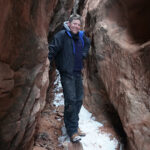 Christopher Ketcham is a journalist who lives in upstate New York and writes at christopherketcham.com and for his journalism nonprofit, Denatured. He is the author of This Land: How Cowboys, Capitalism, and Corruption are Ruining the American West.
Christopher Ketcham is a journalist who lives in upstate New York and writes at christopherketcham.com and for his journalism nonprofit, Denatured. He is the author of This Land: How Cowboys, Capitalism, and Corruption are Ruining the American West.
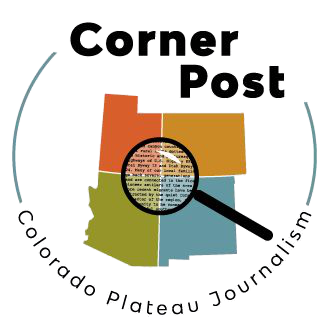
 Corner Post is a member of the Institute for Nonprofit News—a nationwide network of independent, nonprofit, nonpartisan news organizations. Learn more at
Corner Post is a member of the Institute for Nonprofit News—a nationwide network of independent, nonprofit, nonpartisan news organizations. Learn more at  Our stories may be republished online or in print under
Our stories may be republished online or in print under 
9 thoughts on “Hypervisitation, the Fate of the National Parks, and Tourism Toxification in a Small Town”
Thank you Corner Post;
Thank you for this description of a serious and growing problem in the Southern Utah park lands. I only wish it had included specific and actionable suggestions about what the best treatment looks like. My take is that behind the scenes, all the agency managers are completely embedded in a dire political and institutional matrix, not of their creation. I think a focus on alleged “bad actors” will be of little help, as politics will ensure that they are simply replaced with new actors, who will find themselves in the same fix. When the boat is sinking from a hole in the hull, you can put new people on the pumps, but unless the breach is fixed, the end of the story is certain.
Thank you for your comment! We do think that this is just part of a larger story. One of our future goals is to have a dedicated reporter for public lands issues within the Colorado Plateau region and to further the discussion with a focus on solutions. Please, also feel free to send anything that you might like to see covered to admin@cornerpost.org. We welcome any thoughts or comments and can use this information to help develop pitches that we can then match to our freelance journalists.
This is more or less true. I have worn the flat hat in an over-crowded park (though not in the Southwest) and still consult professionally in a place not that far from Moab, a community where I once spent a great deal of time, but that I now, sadly as I have many good memories there, tend to avoid.
What troubles me is not whether this is accurate, but whether it is insightful. It points a finger directly at the National Park Service, an organization that has many problems, some of which I saw first hand as an employee (though I loved working there), and many of which are obvious to any thoughtful observer. But the NPS has also had a large share of dedicated and effective people accomplishing great things over many years.
The author secondarily swipes at the business community. Fair enough, though like the rangers who don’t want to be named, they are responding to the incentives they have. The author takes aim at the recreationists mostly through the eyes of the rangers, but doesn’t probe far in that direction. His choice, but its their demand that drive both the NPS and the business community. Maybe they warrant more attention?
I don’t think, thoguh, this specific reporting necessarily needs more balance. All well thought opinions are valuable and the balancing can take place on a larger stage. But I think this misses the point.
When everyone seems to be at fault – the NPS, the businesses, and the visitors – shouldn’t we be asking if they are all entangled in a system that doesn’t (I would say that by definition, can’t) work. And if the answer is “yes,” which I think it is, shouldn’t we be focusing our ire and our attention that way?
The Park Service makes mistakes. Yep. The business community doesn’t think well about long term consequences. Yep. Visitors have egos. Yep. The question is what do they have in common that results in what Chris describes here.
Thank you for your comment! These are all great points, and we do hope to continue the discussion from here. Public lands and our national parks is a complicated topic, especially for our region, and the west in general, and I would say that each of these points, in turn, most likely warrant their own deep dive. One of our goals in the future is to have a dedicated public lands reporter, and hopefully, we can do just that!
This article is stupid. The author bopped around looking for stressed out NPS employees which aren’t hard to find since the government pays McDonald’s wages in hilariously expensive towns like Moab while stifling any normal social interaction. The average seasonal in the NPS has no idea what they are talking about and indirectly quoting a bunch of them isn’t real journalism. There are no real metrics and no real statistics on park impacts from visitation. This is just the kind of drivel that people love to hear. “It’s so crowded now, you’re killing the park” blah blah blah. This is just well off white people, trust funders, and know it all “dirtbags” lamenting having to share the parks. Just turn them into country clubs if sharing with the proletariat is so bad. Stupid echo chamber crap.
I’m confused. Does the author incorporate the results of the reservation system employed in 2022? We visited then and what the author describes does not match our experiences.
This is my question as well. Not to diminish the multitude of negative effects that hyper tourism is having on the social and economic wellbeing of Moab’s residents (of which I am one), but the timed entry permit system does seem to be a major step in the right direction. I can grab a same-day permit, wait 15 minutes in line at the entrance, find parking in a popular lot, and do a canyon without seeing anyone else on the trail. The park service could honestly reduce total visitation even more and it would only make locals and tourists happier.
We just returned from 2 months as campground hosts in Chaco Culture Park…. it suffers from all the above in regards to rangers, staffing, degrading buildings/housing/water system/signage/trail markers… nothing is being funded. The visitation is small… but the risk factors for those visitors is BIG. Only ONE law enforcement officer, no EMS or paramedic services, and that is a big park with lots of risks to visitors (and campground hosts). It was unsettling to be sure, to be so far from help. The dear volunteers, and worked to death rangers are at wits end. Admin moved to AZTEC (the city), and no longer live in the park to see the daily issues. Luckily we only had a few tense moments, but if things ever go wrong there, they will be REALLY wrong… like a campground full of sick people, because they have no licensed water person to oversee the system… our eyes were opened wide to the difficulties of this particular park… but see that it is NPS wide… bleeding the good parkies and those who really care… from admin/bureaucracy missteps and complacency…..
This article is about 2 years too late and omitting some important developments. Also just takes anecdotal takes of anonymous and former seasonal as gospel- not exactly the best sources to form a convincing narrative point around. One could find the same opinions in any workplace in Moab, it really doesn’t seem to support whatever it is the author is getting at here. It’s a lot of wasted sound and fury at things like the government and employees and not what made Moab what it is now- the frenzy and avarice of a community to attract more, more, more, and a populace who constantly points at others being “the problem”.